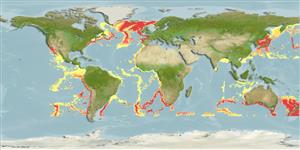Preferred temperature (Ref.
115969): 0.3 - 9, mean 5.2 (based on 654 cells).
Phylogenetic diversity index (Ref.
82804): PD
50 = 0.7539 [Uniqueness, from 0.5 = low to 2.0 = high].
Bayesian length-weight: a=0.00162 (0.00122 - 0.00216), b=3.15 (3.07 - 3.23), in cm Total Length, based on LWR estimates for this species (Ref.
93245).
栄養段階 (Ref.
69278): 3.6 ±0.38 se; based on food items.
回復力 (Ref.
120179): 低い, 4.5年~14年の倍増期間の最小個体群 (Assuming Fec <100).
Fishing Vulnerability (Ref.
59153): High vulnerability (58 of 100).
